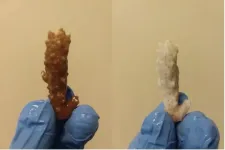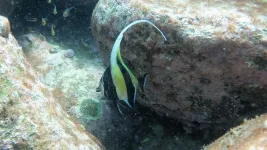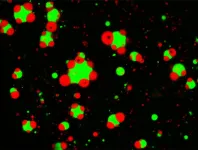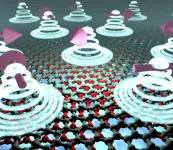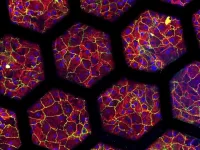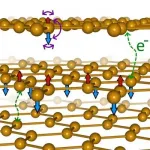(Press-News.org) Coral reefs are beautiful and diverse ecosystems that power the economies of many coastal communities. They're also facing threats that are driving their decline, including the planet's warming waters.
This threat hit extreme levels in 2015, when high temperatures were turning corals white around the globe. Kaneohe Bay in Hawaii was hit hard; nearly half of its corals bleached.
Hidden in the aftermath of this extreme event, however, were biochemical clues as to why some corals bleached while others were resistant, information that could help reefs better weather warming waters in the future. These clues have now been uncovered by researchers at Michigan State University and the University of Hawaii at Manoa.
"It was kind of horrifying," said coral biologist Crawford Drury, who witnessed 2015's bleaching event from Florida before joining UH Manoa's Hawaii Institute for Marine Biology, or HIMB. "It's disheartening to watch, but I try to think of it as an opportunity."
How this disturbing event became an opportunity is now clear thanks to a Feb. 8 report in Nature Ecology & Evolution that showcases HIMB's stewardship and MSU's biochemical expertise.
The researchers discovered chemical signatures in the corals' biology, or biomarkers, that are present in organisms that were most resistant to the bleaching. This previously hidden insight could help researchers and conservationists better restore and protect reefs around the world.
"Usually, we think of biomarkers as signatures of disease, but this could be a signature of health," said MSU's Robert Quinn, an assistant professor in the Department of Biochemistry and Molecular Biology. "This could help us restore reefs with the most resistant stock."
Corals are symbiotic communities where coral animal cells build homes for algae that provide them energy and create their colors. When corals bleach, however, the algae are lost and leave behind skeletons that are susceptible to disease and death.
This symbiosis also plays a role in a coral's resistance and resilience to bleaching, which HIMB was in a unique position to investigate -- literally. The institute sits right next to the reef, enabling experiments in real time.
"The reef is about 100 feet away," Drury said. "I could be there in 30 seconds."
During the 2015 bleaching event, researchers in the Gates Coral Lab at HIMB had tagged individual corals to keep tabs on them. Because most of the corals recovered, the team could follow them over time.
"We think about it as a biological library," said Drury, the principal investigator with the Gates Coral Lab. "It was set up by researchers in our lab who knew it would be very valuable."
Following the bleaching, the team compared and contrasted coral samples in the wild, noting how the organisms responded and recovered, making some surprising observations along the way. For example, neighboring corals could behave completely differently in response to high temperatures. One coral could bleach completely while its neighbor maintained a healthy golden hue.
To understand why, Drury and HIMB postdoctoral researcher Ty Roach, the lead author of the study, sent samples to Quinn at MSU. Here, Quinn and his team could thoroughly analyze the biochemicals of corals collected from this biological library using a method called metabolomics.
"I'm known more for my medical work," said Quinn, who studies the biochemistry of health and disease in humans. "But I've always loved ocean science. My background is in marine microbiology."
If the coral samples are the books in the library, Quinn's lab used sophisticated equipment to reveal the biochemical language within. In particular, his team used tools known as mass spectrometers to understand what set resistant corals apart from susceptible ones.
"The corals are completely different in their chemistry, but you can't tell until you run the mass spec," Quinn said. "These mass specs are some of the most advanced technology on the planet."
Quinn's team found that corals that were resistant to bleaching and those that were susceptible hosted two different communities of algae. The distinguishing feature between these algal populations was found in their cells, in compounds known as lipids.
The researchers' metabolomic analysis detected two different lipid formulations. Bleaching-resistant corals featured algae that have what are known as saturated lipids. Susceptible corals had more unsaturated lipids.
"This is not unlike the difference between oil and margarine, the latter having more saturated fat, making it solid at room temperature," Quinn said.
This discovery poses all sorts of new questions for researchers: How do the corals get these different algae? Is this difference unique to Hawaiian corals or can it be found elsewhere? How can researchers promote the growth and proliferation of resilient corals in a warming world?
"Mass specs are such incredible machines and reveal intricate details of the chemistry involved. The biology is really the hard part." Quinn said. "We're working on new grants. There are so many avenues to explore."
This initial project was funded by the Paul G. Allen Family Foundation.
"This collaboration has been a great opportunity to ask and answer questions," Drury said. "Hopefully, we're just getting started."
In the meantime, having this chemical information is promising for coral conservation. When conservationists reseed corals to help restore reefs, they can potentially select more resilient specimens.
"We can use natural resilience to better understand, support and manage coral reefs under climate change," Drury said.
"Conservation biology has some of the more successful stories in modern scientific history," Quinn said, pointing to the resurgence of elk in Virginia and bald eagles in Michigan. "Someday, maybe we can add corals to that list."
INFORMATION:
(Note for media: Please include a link to the original paper in online coverage: https://www.nature.com/articles/s41559-020-01388-7)
Researchers at the University of Massachusetts Amherst have gained new insight into the biological processes of a chytrid fungus responsible for a deadly skin infection devastating frog populations worldwide.
Led by cell biologist Lillian Fritz-Laylin, the team describes in a paper published Feb. 8 in Current Biology how the actin networks of Batrachochytrium dendrobatidis (Bd) also serve as an "evolutionary Rosetta Stone," revealing the loss of cytoskeletal complexity in the fungal kingdom.
"Fungi and animals seem so different, but they are actually pretty closely related," says Fritz-Laylin, whose lab studies how cells move, which is a central ...
The findings are published in the prestigious journal, Nature Climate Change, and calls on businesses, the financial services industry and regulators to work more closely with climate scientists.
Regulators and governments - both domestic and international - are increasingly requiring that businesses assess and disclose their vulnerability to the physical effects of climate change, for example, increased drought, bushfires and sea level rise.
"People are making strategically material decisions on a daily basis, and raising debt or capital to finance these, but the decisions may not have properly considered climate risk," said lead author Dr Tanya Fiedler from the University of Sydney Business School. ...
Under increasing global warming, tropical fish are escaping warmer seas by extending their habitat ranges towards more temperate waters.
But a new study from the University of Adelaide, published in Nature Climate Change, shows that the ocean acidification predicted under continuing high CO2 emissions may make cooler, temperate waters less welcoming.
"Every summer hundreds of tropical fish species extend their range to cooler and temperate regions as the waters of their natural habitat become a little too warm for comfort," says lead author Ericka Coni, PhD student in the University's School of Biological Sciences. "For at least two decades, Australian temperate reefs have been receiving new guests ...
Recycling cans and bottles is a good practice. It helps keep the planet clean.
The same is true for recycling within cells in the body. Each cell has a way of cleaning out waste in order to regenerate newer, healthier cells. This "cell recycling" is called autophagy.
Targeting and changing this process has been linked to helping control or diminish certain cancers. Now, University of Cincinnati researchers have shown that completely halting this process in a very aggressive form of breast cancer may improve outcomes for patients one day.
These results are published in the Feb. 8 print edition of the journal Developmental Cell.
"Autophagy is sort of like cell cannibalism," ...
BUFFALO, N.Y. -- In cells, numerous important biochemical functions take place within spherical chambers made from proteins and RNA.
These compartments are akin to specialized rooms inside a house, but their architecture is radically different: They don't have walls. Instead, they take the form of liquid droplets that don't have a membrane, forming spontaneously, similar to oil droplets in water. Sometimes, the droplets are found alone. Other times, one droplet can be found nested inside of another. And these varying assemblies can regulate the functions the droplets perform.
A study published on Feb. 8 in Nature Communications explores how these ...
Some coronaviruses can add to their genetic pool some genes belonging to the host they infected. In this way, they can blend in and be less detectable to the immune system. This discovery was published in the journal Viruses by an Italian research team from the IIS (Italian Healthcare Institute), ISPRA (Institute for Environmental Protection and Research), IZSLER (Italian health authority and research organization for animal health and food safety of Lombardy and Emilia-Romagna) and the University of Bologna.
The outcome of this study demonstrates that coronaviruses encompass a sophisticated evolutionary mechanism ...
Electrons in materials have a property known as 'spin', which is responsible for a variety of properties, the most well-known of which is magnetism. Permanent magnets, like the ones used for refrigerator doors, have all the spins in their electrons aligned in the same direction. Scientists refer to this behaviour as ferromagnetism, and the research field of trying to manipulate spin as spintronics.
Down in the quantum world, spins can arrange in more exotic ways, giving rise to frustrated states and entangled magnets. Interestingly, a property similar to spin, known as "the valley," appears in graphene materials. This unique feature has given rise to the field of valleytronics, which aims to exploit the ...
The lung is a complex organ whose main function is to exchange gases. It is the largest organ in the human body and plays a key role in the oxygenation of all the organs. Due to its structure, cellular composition and dynamic microenvironment, is difficult to mimic in vitro.
A specialized laboratory of the ARTORG Center for Biomedical Engineering Research, University of Bern, headed by Olivier Guenat has developed a new generation of in-vitro models called organs-on-chip for over 10 years, focusing on modeling the lung and its diseases. After a first successful lung-on-chip system exhibiting essential features of the lung, the Organs-on-Chip (OOC) Technologies laboratory has now developed a purely ...
Researchers have identified a new form of magnetism in so-called magnetic graphene, which could point the way toward understanding superconductivity in this unusual type of material.
The researchers, led by the University of Cambridge, were able to control the conductivity and magnetism of iron thiophosphate (FePS3), a two-dimensional material which undergoes a transition from an insulator to a metal when compressed. This class of magnetic materials offers new routes to understanding the physics of new magnetic states and superconductivity.
Using new high-pressure techniques, the researchers have shown what happens to magnetic graphene during the transition from insulator to conductor and into ...
A Rochester Institute of Technology researcher has validated a tool measuring adherence to a popular child feeding approach used by pediatricians, nutritionists, social workers and child psychologists to assess parents' feeding practices and prevent feeding problems.
The best-practice approach, known as the Satter Division of Responsibility in Feeding, has now been rigorously tested and peer reviewed, resulting in the quantifiable tool sDOR.2-6y. The questionnaire will become a standard parent survey for professionals and researchers working in the early childhood development field, predicts lead researcher ...
